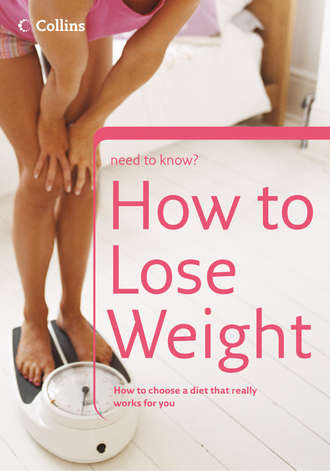
Полная версия
How to Lose Weight

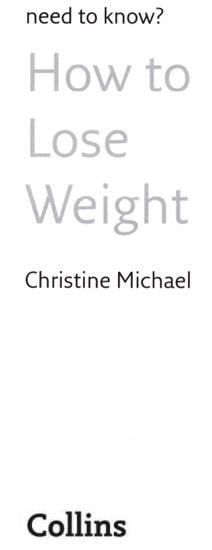
Contents
Cover
Title Page
Introduction
1 The big picture
Assessing your weight and shape
2 Healthy weight, healthier you
Why overweight is a big dea
3 In search of a cause
Why we’re the shape we’re in
4 The science of weight loss
The energy balance
5 Healthy eating for slimmers
Healthy eating for slimmers
6 Choosing a weight loss method
Where to get good advice
Choose the right diet
Calorie-counting diets
Low-carbohydrate diets
Low-fat diets
High-fibre diets
Glycaemic index (Gl) diets
Mediterranean diet
Detox diets
Diuretic diets
Food-combining diets
Crash diets
Food intolerance diets
High-fat diets
Anti-cellulite diets
Body-type diets
Meal replacement diets
Other weight loss methods
Slimming clubs
Slimming websites
7 Exercise: the energy booster
Move it to lose it
8 Making it happen
Confidence and commitment
9 Stay slim for life
Make it a habit
Personal record planner
Glossary
Need to know more?
Further reading
Index
Keep Reading
Copyright
About the publisher
Introduction
There has never been so much information available to us about healthy eating, weight management and exercise, yet the sheer number of regimes and theories can make it even harder to choose a diet and stick to it. This book will guide you through the weight loss maze, equipping you with the information, confidence and motivation you need to achieve your personal slimming and fitness goals.
A guide for life
Around 13 million adults in the UK are watching their weight or are actively ‘on a diet’, yet public health statistics suggest this may be a losing battle. Over half of adults are overweight and one in five is at the ‘obese’ level that represents a significant health risk. So what’s going wrong and how can we reverse a trend that suggests that obesity-related diseases will soon overtake smoking as the biggest single cause of premature death?
Beginning with a self-assessment guide to working out your healthy weight range, you will discover the science behind how we lose weight –and put it on – and learn sound healthy-eating principles to ensure that your slimming campaign is safe as well as effective. With so many diets available, there’s an assessment of 30 different slimming methods, to help you evaluate all the conflicting information and claims that are made about weight loss products and services. And as getting more active is a vital part of a healthy, slim lifestyle, you’ll find a comprehensive guide to boosting fitness and weight loss with the exercise routine that suits you best.
Your chances of success depend on your motivation, confidence and readiness to make the permanent lifestyle changes that are essential to achieving your goal. Find ways to discover your deepest motivations, overcome your inner obstacles and tackle the setbacks that may have led to previous failed attempts at dieting. This book can help you throughout your slimming campaign, providing inspiration, reassurance and support.


1 The big picture
Before you set yourself a weight loss goal, it is a good idea to find out what kind of shape you are in. These days there is more to working out your ideal weight than just standing on the scales, which only tell part of the story. It takes just a few minutes to discover how healthy your weight and shape are and also to decide what you want to aim for.
Assessing your weight and shape
Do you have a weight problem and, if so, how much do you need to lose to reach the weight range that is healthy for you? Here are some easy ways to find out the facts about your figure.
must know
Measure your BMI
To work out your BMI, you need to divide your weight by your height, squared - a calculator is handy to do the sums.
1 To find your BMI using metric measurements, take your weight in kilograms and your height in metres (get someone to check your height for you if it has been a while).
2 Now divide your weight in kilograms by your height in metres, squared. (To turn your weight in pounds into kilos, divide by 2.2; and to turn inches into metres, multiply by 0.025.)



The scientific approach
Most of us have several different ways of keeping an eye on our weight: for instance, we notice when a favourite pair of trousers feels too tight, or when we do not like what we see in the mirror or on the bathroom scales. To assess what your weight really says about your health and wellbeing though, it pays to take a more scientific approach.
If you’ve been in denial about your weight for years, the thought of finding out the cold facts might be daunting, but it might not be as bad as you think. Many people have a fixed idea about what their weight ‘should be’, and often it’s based on the slim figure they had as a teenager or on their wedding day, which might not be comfortable or realistic for them now. And if the truth about your weight does come as an unpleasant shock, turn that feeling into a motivational boost. Now that you are about to start a healthy weight loss campaign, you need never see that figure on the scales again.
Body Mass Index
A simple weight-and-height comparison used to be the favoured method of assessing whether someone was overweight or not. Today health professionals prefer to use the Body Mass Index (BMI), a figure that represents your weight per square metre.
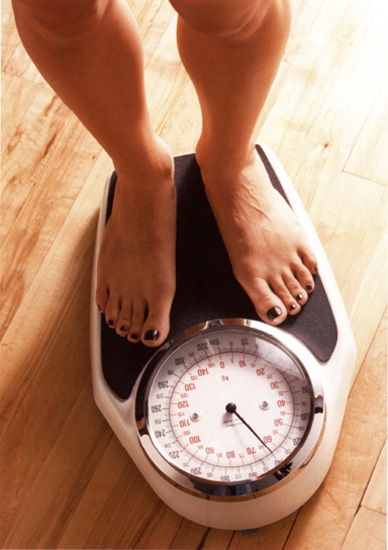
must know
Obesity
Over 20 per cent of British women are obese yet in a Cancer Research survey only four per cent said they were. The health risk starts increasing before it reaches the point where you may look or feel extremely overweight.
Key to the BMI chart

BMI under 18.5: underweight.
You do not need to lose weight and may even have an increased risk of certain medical conditions that are linked to low body weight, such as osteoporosis (‘brittle bones’).


BMI 18.5 – 24.9: normal.
You do not need to lose weight for medical reasons. If you are at the top end of the range, it is worth taking care to eat healthily and exercise regularly to ensure you don’t creep into he ‘overweight’ range.


BMI 25 – 29.9: overweight.
A BMI of 25-plus indicates that you are over your ideal weight, and in this range you start to increase your risk of developing weight-related health problems. Aiming to lose a few pounds (or more, depending on where you are in the range) will benefit your health.


BMI 30 – 39.9: obese.
Within this range you are probably at least 14 kg (30 lb) or more over your ideal healthy weight and are running a ‘moderate’ risk of weight-related medical conditions. As a starting point, losing 10 per cent of your body weight will considerably reduce this risk. If your BMI is between 35 and 39.9, the risk it could pose to your health is classified as ‘severe’. A determined effort to lose weight and lower your BMI is worth making a top priority.


BMI 40 or over: extremely obese.
If you are within this range, then you are probably already experiencing weight-related symptoms and difficulties. Tackling your weight is important and urgent; see your doctor to discuss the various options and to access specialist advice.

BMI is based on the assumption that the difference between people who are the same height, but different weights, generally reflects how much fat they have on their bodies. So for assessing health status, BMI is a more accurate measurement than weight versus height alone, as it takes body composition into account.
must know
BMI facts




What your BMI means
The World Health Organization (WHO) has established that a BMI of between 18.5 and 24.9 is ‘normal’, by which it means that someone whose BMI is within this range has the least risk of developing weight-related health problems.
A BMI of 25–30 is considered ‘overweight’, with an increased risk of developing weight-related illnesses, such as certain cancers, heart disease and type 2 diabetes. The higher your BMI above this level, the more the risk to your health increases and the more you will benefit by losing weight: losing just five to 10 per cent of your body weight and keeping it off can make a difference, so it’s well worth aiming for.
Waist management
Your waist measurement is another important indicator of whether you are in healthy shape or not. This is because research has shown that where we carry any excess weight on the body is just as crucial to our overall health as how much extra we might have.
It appears that too much fat around the stomach, seen as an apple shape or ‘beer belly’, plays a damaging role in increasing the body’s resistance to insulin, which in turn can lead to an increased risk of type 2 diabetes and heart disease. Someone who is an ‘apple’ shape will have a greater risk of health problems than someone of the same weight who carries their weight around the hips, thighs and bottom (the classic ‘pear’ shape).
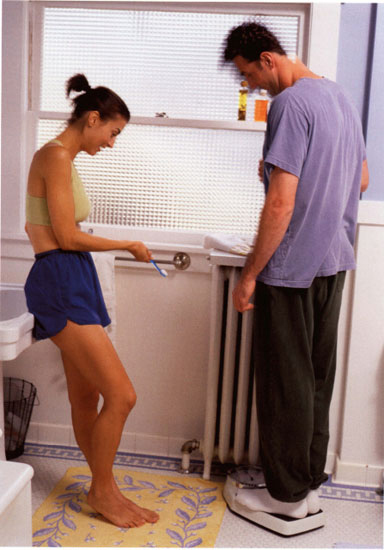
To work out your BMI, accurately you will have to weigh yourself.
must know
Body fat
An average healthy man has about 15–20 per cent body fat; an overweight man would have about 25 per cent body fat; and an obese man, 35 percent or more. For women, the figures are 25–27 per cent; 30 per cent; and 35 percent respectively. You can have your percentage of body fat measured: common methods include skin-fold callipers, bioelectrical impedance or dual energy X-ray absorptiometry.
Measure your waist
To measure your waist, keep the tape measure flat and hold it firmly but not too tightly against your skin. The place to measure is the midpoint between the bottom of the ribs and the top of the hip bone, about 2.5 cm (1 in) above the navel.
Check the table below to see how healthy your waist measurement is. If your BMI is in the normal range but your waist is in the ‘increased risk’ category, it would be a good idea to lose some weight to slim your waist and stomach.

Going pear-shaped is not bad news for ur health.
Note: Asian people with ‘apple’–shaped waists have been found to be at higher risk of developing health problems than other groups. Asian men with a waist measurement of 90 cm (36 in) or more, and Asian women whose waist is in excess of 80 cm (32 in) are in the ‘high risk’ group.
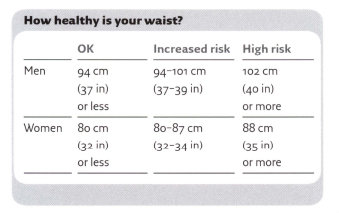
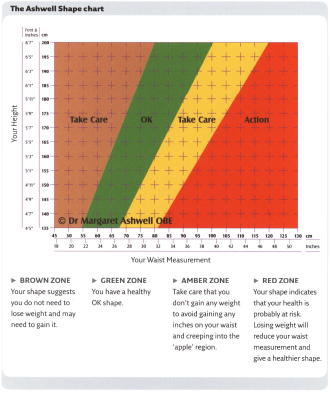
Does your waist shape up?
The Ashwell Shape Chart (opposite) was developed by leading nutritionist Dr Margaret Ashwell and is an at–a-glance way of checking whether your shape, as determined by your waist and your height, is in a healthy range or not. To use the chart, just read off your height in a horizontal line and your waist measurement in a vertical line. The point where the two lines meet is where your shape is on the chart.
Apple shapes
Fat seems to be more easily lost from ‘apple’ shapes than from ‘pears’, and this could help to explain why men often seem to slim more quickly than women. Being stressed stimulates production of the hormone cortisol, which is known to play a part in distributing stored fat in the central abdominal area, and this could contribute to an ‘apple’ shape. Fat stored in the central area is found deep down in the region of the stomach, while fat on the hips, thighs and bottom is stored nearer the surface of the skin. This can give it the ‘orange peel’ texture known as cellulite, so it is a small consolation that while it may not look attractive, it is less harmful to health than central abdominal fat.
Quick measures



want to know more?
Take it to the next level. . .




Other sources







2 Healthy weight, healthier you
Taking care of your weight is one of the most important things that you can do to maximize your chances of living a long and healthy life. The good news is that if you are overweight, you don’t need to slim down to a ‘perfect’ size in order to reap the health benefits – every pound that you lose can help, which is great motivation to get started.
Why overweight is a big deal
Carrying excess weight means increasing the risk of health problems, either as a direct result of being heavier or from the likelihood of developing diseases in later life. Being aware of this is the first step to feeling more in control of your weight and your health.
must know
Stop smoking
Smoking is a bigger hazard to health than being overweight, yet some people - especially women - smoke to help keep their weight down. Giving up smoking does not mean you will automatically put on weight but weight gains of 1.8–3.2 kg (4–7 lb) are common; this seems to be because food tastes better and people snack more rather than any physiological reason. Trying to stop smoking and lose weight at the same time is a big job. Tackle smoking first, aiming to minimize any weight gain by eating healthily and being as active as possible – and then make your weight a priority.
Awareness, not worry
Good health would be top of most people’s list of ingredients for a happy life, and in an ideal world, we would choose to avoid illness and disability if we possibly could. In the real world, of course, we have to play with the cards that life deals us, and many of the factors that determine our long-term health are beyond our control.
However, that does not mean that we should not try to change the odds in our favour whenever we can do so. The overwhelming evidence, from scientific research that has been carried out around the world, is that managing our weight is one of the optimum ways to give ourselves the best possible chance of living a long, healthy and active life.
Consumer studies suggest, however, that improving their health is not always the main reason why people start a diet or fitness regime. About half of slimmers, especially younger ones, say that they want to lose weight in order to look better in clothes, or for a special occasion such as a forthcoming holiday or wedding. And that’s absolutely fine!
It is fantastic to know that you look your best, and to be able to wear whatever you want and to enjoy looking at your holiday photos instead of dreading them.
All too often, for health to become the main motivator to embark on a slimming regime it takes a crisis: perhaps your doctor warns that your blood pressure is too high, or recommends you lose weight before trying for a baby, or you find that you are increasingly breathless and uncomfortable.
But health can be a positive motivator as well as a cause of fear and worry. Skim through this section, and you will see that while some of the health implications of being overweight are serious, it does not take a massive weight loss to reduce your risk of developing problems, or to improve symptoms that might be bothering you already. If you only have a little weight to lose, knowing that you are benefitting your health by reaching and maintaining your target weight can be a deep source of satisfaction – in addition to the joys of shopping for smaller clothes.



